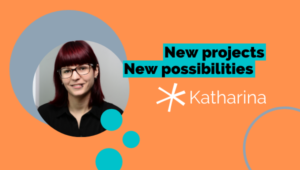
Our Student Trainees | Series
Software development and cloud computing require continuous development to steadily improve current operating principles. A significant job in this regard is done by our student trainees, who intensively work on projects that show us new technologies and approaches.
Katharina joined tracekey as a student trainee for software development in March 2020. The topic of her bachelor thesis are virtual work environments, more specifically virtual machines and containers. Therefore, she had a closer look at the technologies themselves and has moreover examined the “Safety Aspects of Implementing Containers Based on Open Source Technologies“. Her conclusion: “It would be wrong to say that there is a higher risk of working with containers than working with virtual machines. There are several benefits using containers for software development. Thanks to the knowledge I have gathered over the last six months and the IT security knowledge already found at tracekey, the safety fundamentals for the pharmaceutical industry’s sensitive data are accomplished.”
What are containers?
A container is a standardized software unit. It contains, for instance, codes, system libraries, configuration files, or runtime. Containers are used by developers to ensure a more flexible working environment as it enhances accessibility and exchangeability. Therefore, the application (software) is containerized and runs independently from the working environment while keeping all functions and dependencies.
What are the advantages of using containers?
The major advantage is the portability of containers between work environments. In comparison to virtual machines, that need to be set up manually in every working environment in which an application should run, containers can be moved from e.g. the local programming environment to the test as well as the production system. As all necessary files and functions are comprised in a container, it can be moved easily and fully operable.
The ongoing container project could be used to gradually run all applications in containers in the medium term. As a result, all developers could work in the same environment under equal conditions as the containerized software runs independently from all other infrastructure.
Becoming one team while working from home
Katharina joined tracekey just as we were shifting to home working due to Covid-19 in March 2020. Despite quickly going into remote work, she says that working as a team has never been an issue: “There are several things that keep me motivated while working from home. Especially the topic I’m doing research on – I started to actively work with the cloud and at that moment I am keeping myself busy with the MediLedger Host from our DSCSA-solution. Furthermore, I really like working with my colleagues. It is great to get encouraged and supported while learning new things, to be fully integrated into the team, and to get the opportunity to work in a field that is novel to me. This is what keeps me learning and working. I really like the open and positive mindset of my team.”
The Future
Meanwhile, our development team is conducting a longer trial run on how useful an implantation of containers into the daily routine of tracekey would be. Based on Katharina’s project, and providing that the test results are positive, containerization could be implemented as a standard method. Our greatest advantage would be a consistent environment that ensures for the software to always being up to date during further development. This would also make the software testing and supply to our customers easier. Whether and to which extend the container project will be implemented is going to be examined during the test phase. Katharina, however, has provided the basis for this possible improvement and we are proud to announce that she will join tracekey as a permanent team member after her graduation.